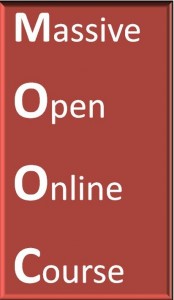By MollyJust
What is a MOOC anyway?
MOOCs are massive open online courses. As opposed to traditional courses that have tuition and limited enrollment, MOOCs are free and open to the masses.
How are MOOC’s structured?
The large numbers associated with MOOCs mean that instructors can not possibly respond to students on an individual basis. Classmates therefore rely on each other, organizing online study groups and working in online forums for help. Lectures are given via video and in-lecture quizzes make sure you understand the material. Teaching assistants oversee discussion boards and feedback for homework and exams is electronic.
Where did the idea for MOOCs come from?
The roots of massive online open courses can be traced back to the American inventor Douglas Engelbart who advocated for the utilization of the computer as a cooperative tool for intellectual growth. Since then, many educational reformers have advocated for the use of computing technology integrated into the learning process and openness in the educational process.
In 2004, an early version of the MOOC was developed by Sun Microsystems. Concepts and lessons learned from these approaches influenced a nonprofit organization, Curriki, which has created an online repository/community for curricula and has more than 300,000 educator, parent, and student members. Curriki’s online community connects educators from around world and enables the sharing of curriculum and best practices.
In the fall of 2011, the idea of a global community of learning gained massive attention when more than 160,000 people signed up for an artificial intelligence course offered by Sebastian Thrun and Peter Norvig (through the company now known as Udacity). Following the popularity of Thrun and Norvig’s course, Daphne Koller and Andrew Ng launched two MOOC’s from Stanford University through the company Coursera. MIT later that fall launched MITx as an effort to develop a free, open platform for online education. The first course launched in March 2012 was 6.002x with more than 155,000 participants. Harvard and the Berkeley joined MIT’s initiative later that year and MITx was renamed edX.
In reference to MOOCs, Anant Agarwal president of edX said that he would “like to call this year the year of disruption and the year is not over yet.” This fall, edX has more than 370,000 students in its inaugural classes. Coursera, now offering courses from 33 of the most elite universities, has reached more 1.7 million students.
The rise of MOOCs means that we should begin thinking about how free, top-quality education can change our world. The education that can be spread through MOOCs is not limited by geography or political boundaries. 60% of students in MOOCs are ambitious young people from countries like India, Brazil and China. Will supersized education be the propellant needed to spur innovation globally? Will MOOCs knock down the barriers to a good education? We can only hope.
Related articles
- MOOCs for Credit (distance-educator.com)
- Massive Open Online Courses Are Multiplying at a Rapid Pace (nytimes.com)
- MOOCs going Massive (currikiblog.wordpress.com)
- Canvas Network – Are the LMS and MOOC Markets Colliding? (mfeldstein.com)
- MOOCs Are the Monkey Wrench Thrown Into Online Learning (tutoringtoexcellence.blogspot.com)
- MOOC Mania (news.slashdot.org)



Leave a Reply
You must be logged in to post a comment.